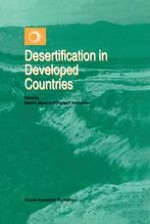1995 | OriginalPaper | Chapter
Government Policy Influences on Rangeland Conditions in the United States: A Case Example
Authors : Jerry L. Holechek, Karl Hess Jr.
Published in: Desertification in Developed Countries
Publisher: Springer Netherlands
Included in: Professional Book Archive
Activate our intelligent search to find suitable subject content or patents.
Select sections of text to find matching patents with Artificial Intelligence. powered by
Select sections of text to find additional relevant content using AI-assisted search. powered by
Since the early 1970s the Bureau of Land Management (BLM) and the Forest Service have emphasized the monitoring approach in managing their rangelands. After a 5-year period of intensive monitoring, stocking rate and other management actions are typically adjusted, depending on whether a definite downward or upward trend in range condition is observed. Examining the Afton Allotment on BLM land in southcentral New Mexico, we demonstrate serious flaws in the monitoring approach and other BLM grazing policies. Monitoring reflects past management but does not consider the future. Perverse incentives for permittees to maximize permit value rather than sustain the forage base still remain in place. The “Range Reform ′94” proposals by the U.S. Department of the Interior do not address these incentives and other flaws in public land policy. We would reform federal grazing land policy by coupling grazing fees to grazing intensity. Ranchers choosing conservative sustainable grazing intensities would pay low fees, whereas those choosing heavy grazing intensities would be charged higher rates. We would also implement other reforms: making livestock grazing permits transferable to other uses, discontinuing subsidies, eliminating restrictions on nonuse, offering incentives for public land investment, and establishing a biodiversity fund.
